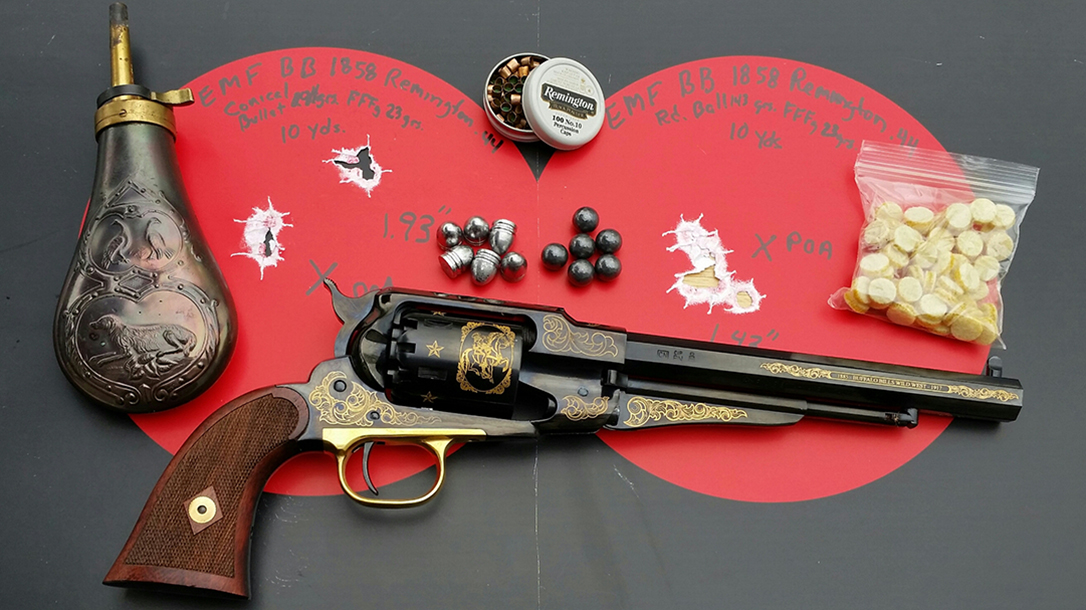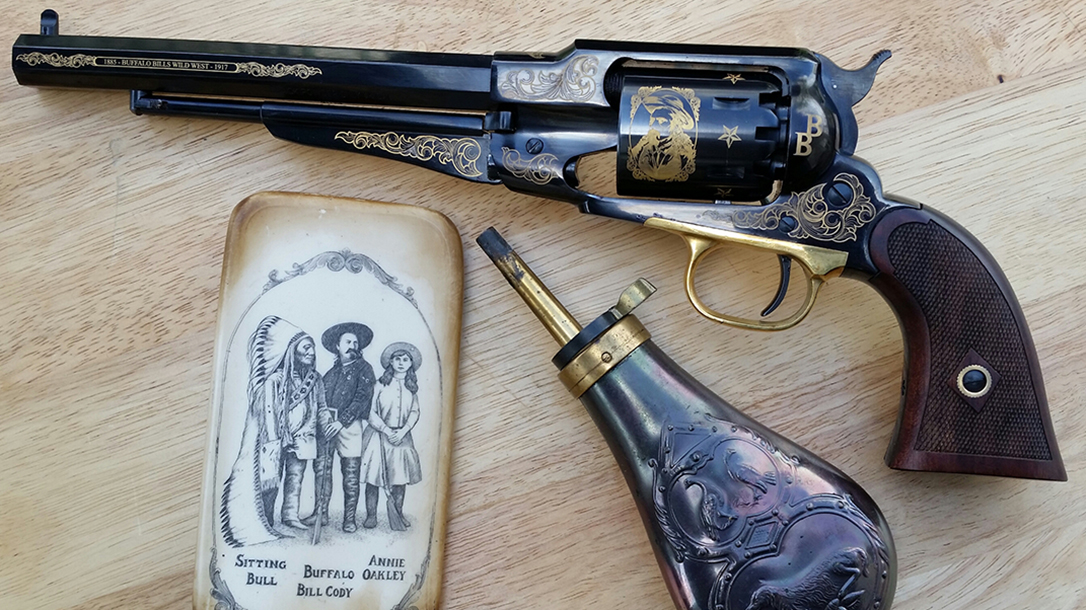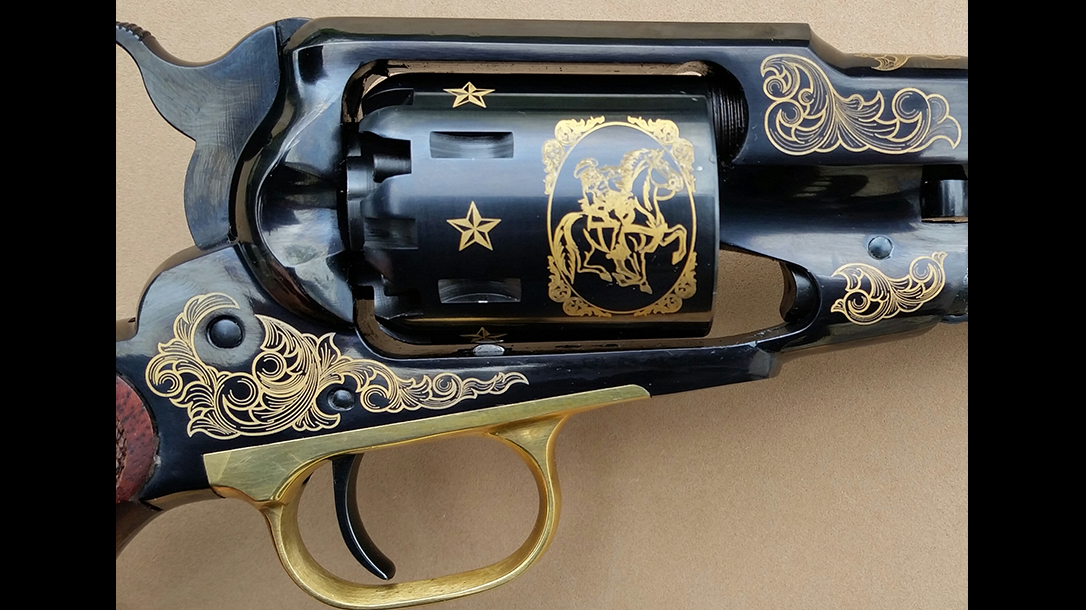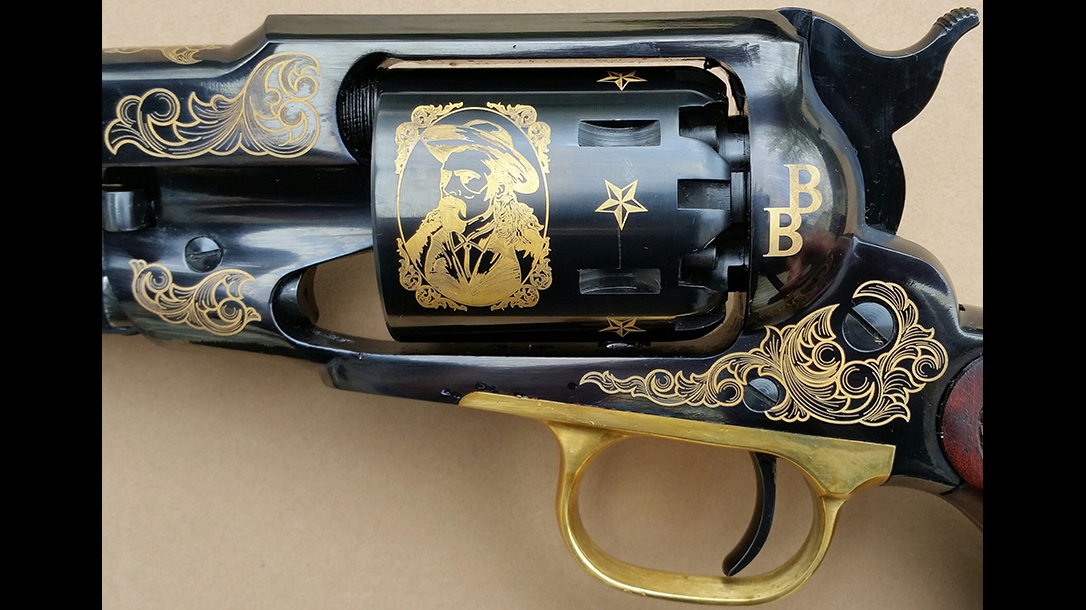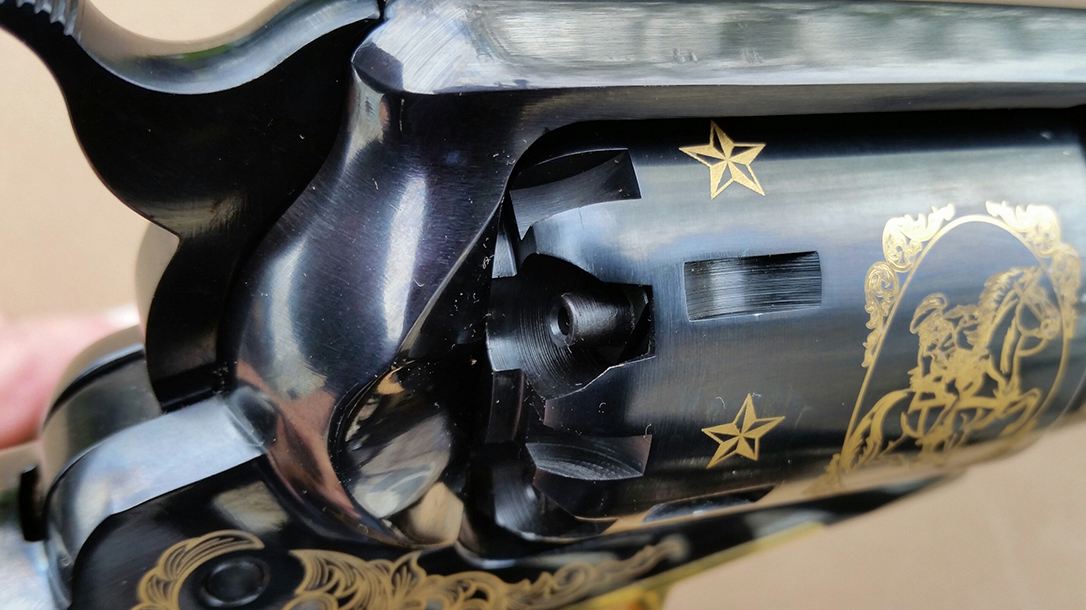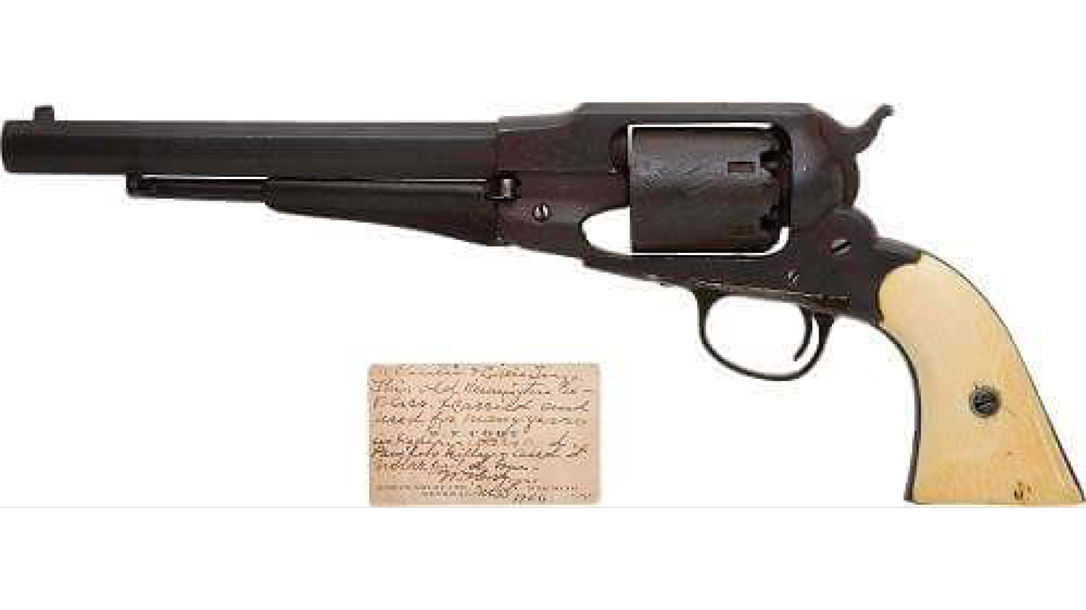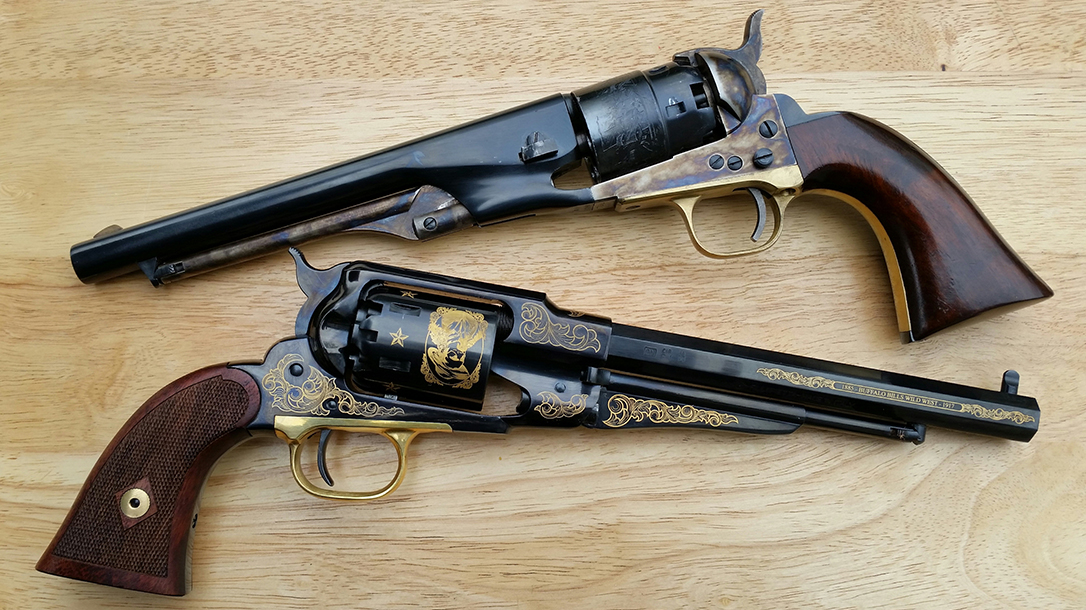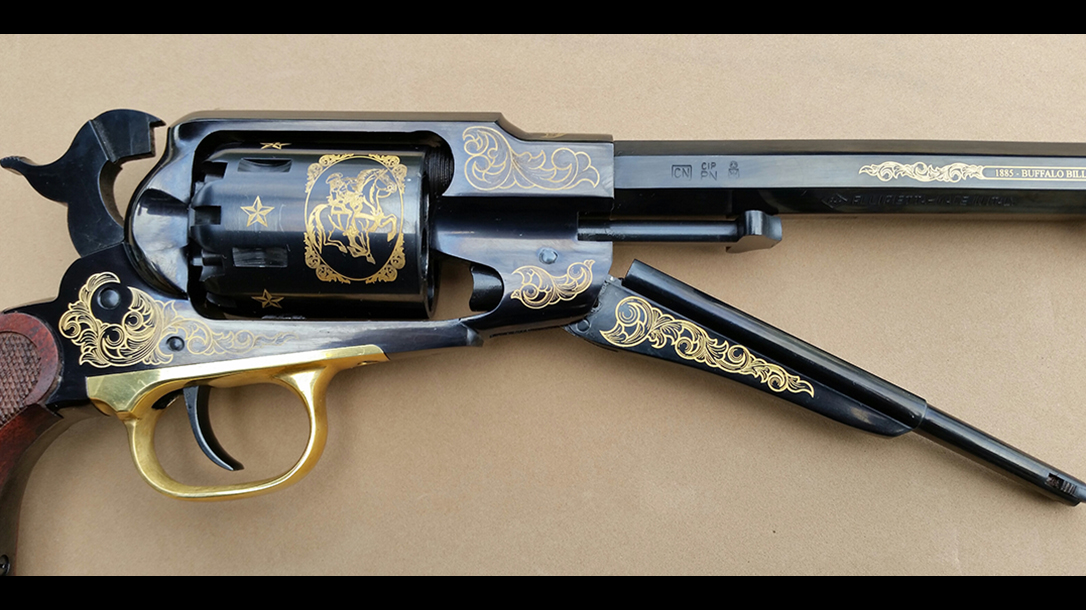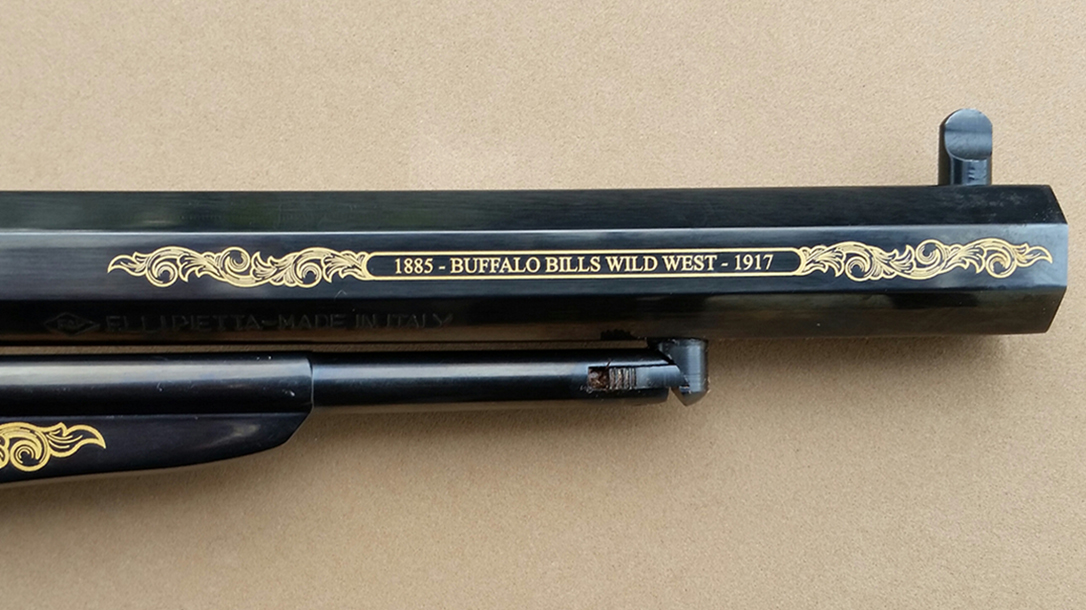The second most-issued percussion revolver during the Civil War has become known as the Remington Model 1858. This designation is somewhat erroneous, however, as it’s based on the date of Sept. 14, 1858, when the patent was granted to inventor Fordyce Beals. The first version was called the Remington-Beals Army revolver, and it had a large frame, an 8-inch barrel and a six-shot cylinder in .44 caliber. Beals had also worked with Remington on other percussion revolver designs in smaller .31 and .36 calibers. The Remington Army did not go into serious production until 1861, and less than 8,000 were made before the New Model Army revolver became the standard design in 1863, with some 122,000 made before production ceased in 1875. There was really little difference in the Army model versions—mostly improvements to the cylinder, loading lever and hammer, as suggested by the U.S. Ordnance Department.
Competing Designs
Unlike its chief competitor, the Colt Model 1860 Army, the Remington Army had a topstrap that added strength to the design of the gun and provided for a better rear sight. It also added a bit more bulk and 2 ounces of weight. One big plus was the ease of cylinder removal. To do this, the hammer was put on half-cock and then the loading lever was pulled down far enough to expose the T-shaped base-pin head, which was used to pull the base pin out. The cylinder could then be removed from the left side of the frame window. It could then be replaced with a loaded cylinder.
Advertisement — Continue Reading Below
The Colt, on the other hand, had a barrel wedge secured with a screw that had to be removed to free the barrel/loading lever unit, which was pulled forward off the base pin, allowing the cylinder to be removed. It wasn’t something you’d want to do on the back of a horse or in the heat of battle. The open-top design of the Colt did make it less susceptible to blackpowder fouling. The fouling could build up after firing just a few loaded cylinders. Exploded percussion caps seem less likely to fall into the action of a Remington Army due to the topstrap, at least in my experience.
At the conclusion of the War Between the States, many issued sidearms were “liberated” or sold as surplus. Thus, the Remington made its way west with military veterans looking to make a better life. Frontiersmen, settlers, cowboys, outlaws and lawmen found favor with the big Remington Model 1858, which explains its continued production several years after revolvers began to be made for self-contained metallic cartridges.
Buffalo Bill
One of the adherents of the Remington percussion .44 was William F. Cody. Raised in “Bleeding Kansas” in the pre-war years, there’s conjecture on whether he was involved in any fighting. He became a rider for the Pony Express during its history from 1860 to 1861; Bill Cody was likely introduced to the Remington New Model Army revolver in 1868. That’s when he became an Army scout for General Philip Sheridan. Cody’s revolver, serial number 73293, had a standard blued finish and was fitted with ivory grip panels.
Advertisement — Continue Reading Below
As a scout, Cody carried dispatches or rode out ahead of the soldiers he was guiding to get as close to hostile Indians and gain information before an attack. This was dangerous work; a good, reliable revolver would provide at least a small measure of comfort. Bill Cody was credited with a number of heroic actions during his service from roughly 1868 to 1876. He made long rides to warn frontier forts of impending attacks, led the 5th Cavalry to a large hostile Indian village, resulting in a mounted charge and victory. He led hunting parties like the one for the Grand Duke Alexei Alexandrovich of Russia.
In 1872, Cody and an Army sergeant battled hostile Indians who had raided a station near an Army outpost. Outnumbered two to one, they fought on horseback and three of their foes were killed—at least one directly attributed to Cody. For this action, he was awarded the Medal of Honor. Cody became “Buffalo Bill” as a professional meat hunter for the railroads. He later created “Buffalo Bill’s Wild West” and was an internationally famous showman for the remainder of his life. Cody’s old Remington Model 1858 was sold towards the end of his career along with a note saying, “It never let me down.”
Enter EMF
Now EMF Company is offering a Pietta-made Remington Model 1858 replica to commemorate Buffalo Bill. I saw one of these revolvers at a firearms trade show and was immediately taken with it. As a devotee of Col. William F. Cody, I requested one for testing, and it didn’t take too long before an example was in my hands.
Advertisement — Continue Reading Below
Hands On
The Buffalo Bill Commemorative is a .44-caliber New Model Army with an 8-inch barrel. It has a polished, blued finish and is embellished with gold-filled etchings paying tribute to Buffalo Bill. The receiver has gold scrollwork on the sides, below the recoil shield and forward of the cylinder window, as does the loading lever. More scrollwork adorns the barrel, and “1885-BUFFALO BILLS WILD WEST-1917” is engraved on both sides. The left-side recoil shield has a gold “BB” while the cylinder has a head-and-shoulders portrait of Cody. On the opposite side you’ll find another etching of him on horseback. On the whole, I think the embellishments are tasteful and well done.
The two-piece walnut grip panels are finely checkered with a diamond pattern encircling the grip screw. The triggerguard is made of polished brass and offers a pleasing contrast. Overall, the fit and finish get high marks in my book!
About The New Model Army
A few other notes on the Remington New Model Army are in order. The front sight is a high “pinched” post with a rounded top, which gives a much better sighting picture than a Colt with its small, silver blade front sight and V-notch in the hammer nose for a rear sight. When you put the Remington hammer on half-cock and release the loading lever from its locked position, the cylinder has turned just enough so the rammer doesn’t go into a chamber mouth, but the lever is low enough so you can remove the base pin and cylinder.
Advertisement — Continue Reading Below
The locking notches on the cylinder are oversized, and the bolt is large. There are also generously sized cuts between the nipples at the rear of the cylinder for the hammer nose to rest in safely. It appears that the nipples turn outward ever so slightly to make capping easier. The trigger on my gun was wide and smooth with a crisp pull breaking at about 4.5 pounds. The hammer spur is deeply serrated for ease of cocking.
More Than Looks
Yes, I know it’s a pretty gun, but I wanted to see if this gun was more than just its looks. My powder flask for .44-caliber handguns throws a 23-grain charge of Goex FFFg black powder, and I had 0.454-inch lead balls that weighed an average of 143.8 grains as well as conical lead bullets measuring 0.45 inches and weighing an average of 194.7 grains. My Oehler chronograph showed the average velocity of the lead ball ammunition to be 642 fps while the conical bullets, though a tad heavier, gave an average velocity of 702 fps.
To test the gun on paper targets, I loaded each cylinder with powder, a “Wonder Wad” and a lead ball, then capped the nipples with Remington #10 percussion caps. I put a large bullseye target out at 10 yards and squeezed off six shots from a sandbag rest, aiming at the center of the red aiming circle. When the smoke cleared, I was pleasantly surprised to see my shots going a little left and just below the point of aim (POA). My best group of three 6-shot groups measured 1.43 inches with all of the bullet holes touching.
Advertisement — Continue Reading Below
I did the same loading regimen with the conical bullets; the only difference is that I had to remove the cylinder to load the longer bullets and use a wooden mallet to position them before replacing the cylinder and doing the final seating with the loading lever. My best group with the conical bullets was 1.93 inches, and it was actually two rather small three-shot groups a little over an inch apart. The POA was the same, and the point of impact (POI) was 0.5 to 1.5 inches high.
Additional Testing
To see how the Buffalo Bill Commemorative translated to steel targets like I’d use in Cowboy Action Shooting competitions, I loaded up the Remington and repaired to the “cowboy” portion of the range. With both lead balls and conical bullets, I had 100-percent hits shooting in “Duelist” mode with only one hand at steel targets placed about 5 to 7 yards away. During the testing, I had no malfunctions whatsoever, and no caps fell into the cylinder star or action to jam things up. After a good cleaning, the gold etching was still present—it was just a bit darker in a couple of places on the cylinder.
Advertisement — Continue Reading Below
I was also lucky enough to use the Buffalo Bill Commemorative in a local Cowboy Action match. The day’s event consisted of six match stages, and I elected to shoot in the two-gun, blackpowder Duelist class. I didn’t use any fancy gadgetry; I just loaded the gun in the field and checked it between stages for excess fouling. There was one miss on a moving target during the match with the Remington; I gained some extra points by hitting an optional long-distance target placed about 50 yards away. There were no malfunctions, and the gun shot to the POA and was very easy to cock even using only my strong hand. Again, the gold etching remained after another cleaning, and I came away very impressed with the gun’s looks and performance.
EMF Model 1858 Buffalo Bill Commemorative Specs
| Caliber: .44 |
| Barrel: 8 inches |
| OA Length: 13.5 inches |
| Weight: 32 ounces (empty) |
| Grip: Walnut |
| Sights: Fixed |
| Action: SA |
| Finish: Blued, gold etchings |
| Capacity: 6 |
| MSRP: $745 |
EMF Model 1858 Buffalo Bill Commemorative Performance
| Load | Velocity | Accuracy |
|---|---|---|
| 144 Ball/23 FFFg | 642 | 1.43 |
| 195 Bullet/23 FFFg | 703 | 1.93 |
*Bullet weight measured in grains, velocity in fps by chronograph and accuracy in inches for best five-shot groups at 10 yards.
For more information, visit emf-company.com.
Advertisement — Continue Reading Below
This article was originally published in “Guns of the Old West” summer 2017. To order a copy and subscribe, visit outdoorgroupstore.com.
